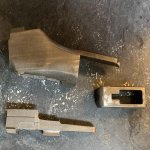Anyone have any experience making their own highwall from a casting kit ?
I have the castings for an 1885 from Boulder river foundries.
It’s complete with all internal parts less the screws, pins and springs , anyone have a line on a supplier for the extra bits I need ?
Im a journeyman machinist with years of experience but I’ve never taken on a full build like this before .
Any advice and tips would be greatly appreciated.
IRRC, Boulder River is/was the supplier to Montana Vintage Arms.
But in any case, I suggest going over every part, very carefully, and plotting out the dimensions and tolerances you wish to follow, well before you cut anything off the castings, so as to be certain that you do not paint yourself into the figurative corner, and end up with parts that are either not fitting together, or not able to be actually made from the castings as supplied.
Some quality time with a surface plate, a surface gage, and some form of marking out fluid is the most common recommendation I have read. Liquid paper or a coat of primer-surfacer, may serve well.
A question topical to above, did the castings come from a source that also was willing to supply plans? Are they dimensioned and toleranced? There are a lot of generic Win 1885 plans sets around, not all say the same things, as they were mostly built up by guess and by golly, from guys measuring various old Winchesters. As generic references, they provide only about half the info you will actually need to make the castings into a working firearm. And depending on how different they are from the actual castings in hand, may lead you down a right 'garden path', that you may not be able to recover from.
Screws and pins, you are expected to make yourself, rather than buy, but there are a few guys stateside that have been making screw kits for old guns if you don't mind the cost, if you can get them to send them out. Springs same, you can make or buy them.
If you can borrow copies of Campbell's two volumes on the Winchester Single Shot, they would prove to be pretty damn good references, if you wanted to copy a factory gun as near as possible. If you are OK with that the parts will never go on a factory gun, and factory parts are never gonna fit on yours, then refer back to my very first suggestion. Build it on paper first. If you are into dicking about with the various softwares out there, you can make a 3D rendered set of parts and check clearances and operation, before making any parts, if you would like to.







































































